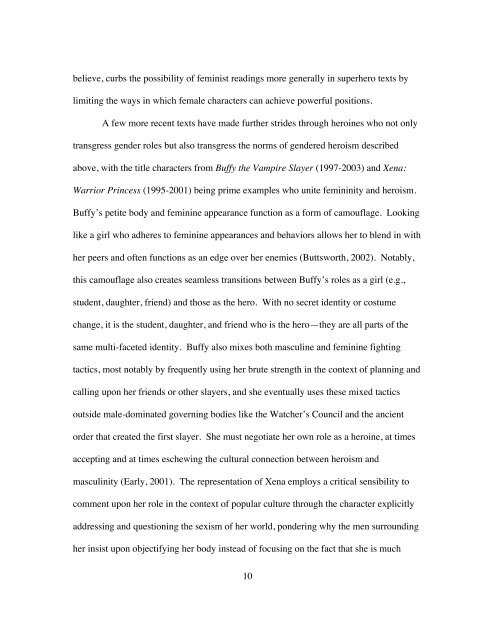Gender, Feminism, and Heroism in Joss Whedon and John ...
Gender, Feminism, and Heroism in Joss Whedon and John ...
Gender, Feminism, and Heroism in Joss Whedon and John ...
Create successful ePaper yourself
Turn your PDF publications into a flip-book with our unique Google optimized e-Paper software.
elieve, curbs the possibility of fem<strong>in</strong>ist read<strong>in</strong>gs more generally <strong>in</strong> superhero texts by<br />
limit<strong>in</strong>g the ways <strong>in</strong> which female characters can achieve powerful positions.<br />
A few more recent texts have made further strides through hero<strong>in</strong>es who not only<br />
transgress gender roles but also transgress the norms of gendered heroism described<br />
above, with the title characters from Buffy the Vampire Slayer (1997-2003) <strong>and</strong> Xena:<br />
Warrior Pr<strong>in</strong>cess (1995-2001) be<strong>in</strong>g prime examples who unite fem<strong>in</strong><strong>in</strong>ity <strong>and</strong> heroism.<br />
Buffy’s petite body <strong>and</strong> fem<strong>in</strong><strong>in</strong>e appearance function as a form of camouflage. Look<strong>in</strong>g<br />
like a girl who adheres to fem<strong>in</strong><strong>in</strong>e appearances <strong>and</strong> behaviors allows her to blend <strong>in</strong> with<br />
her peers <strong>and</strong> often functions as an edge over her enemies (Buttsworth, 2002). Notably,<br />
this camouflage also creates seamless transitions between Buffy’s roles as a girl (e.g.,<br />
student, daughter, friend) <strong>and</strong> those as the hero. With no secret identity or costume<br />
change, it is the student, daughter, <strong>and</strong> friend who is the hero—they are all parts of the<br />
same multi-faceted identity. Buffy also mixes both mascul<strong>in</strong>e <strong>and</strong> fem<strong>in</strong><strong>in</strong>e fight<strong>in</strong>g<br />
tactics, most notably by frequently us<strong>in</strong>g her brute strength <strong>in</strong> the context of plann<strong>in</strong>g <strong>and</strong><br />
call<strong>in</strong>g upon her friends or other slayers, <strong>and</strong> she eventually uses these mixed tactics<br />
outside male-dom<strong>in</strong>ated govern<strong>in</strong>g bodies like the Watcher’s Council <strong>and</strong> the ancient<br />
order that created the first slayer. She must negotiate her own role as a hero<strong>in</strong>e, at times<br />
accept<strong>in</strong>g <strong>and</strong> at times eschew<strong>in</strong>g the cultural connection between heroism <strong>and</strong><br />
mascul<strong>in</strong>ity (Early, 2001). The representation of Xena employs a critical sensibility to<br />
comment upon her role <strong>in</strong> the context of popular culture through the character explicitly<br />
address<strong>in</strong>g <strong>and</strong> question<strong>in</strong>g the sexism of her world, ponder<strong>in</strong>g why the men surround<strong>in</strong>g<br />
her <strong>in</strong>sist upon objectify<strong>in</strong>g her body <strong>in</strong>stead of focus<strong>in</strong>g on the fact that she is much<br />
10

















